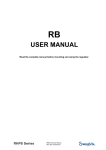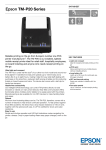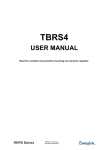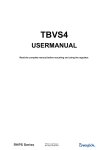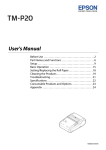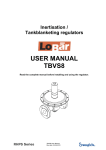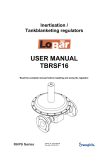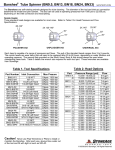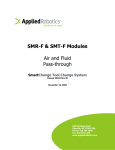Download bs(h)20 user manual
Transcript
BS(H)20 USER MANUAL Read the complete manual before installing and using the regulator. 2 CONTENTS 1 Introduction ......................................................................................................................................... 4 1.1 2 Description .................................................................................................................................... 4 Installation ........................................................................................................................................... 4 2.1 Points of attention before installation ........................................................................................... 4 3 Operation ............................................................................................................................................. 4 4 Maintenance ........................................................................................................................................ 5 4.1 5 Disassembly ................................................................................................................................. 5 Trouble shooting ................................................................................................................................ 6 BS(H)20 User Manual Rev.date: 20-09-2010 3 WARNING INCORRECT OR IMPROPER USE OF THIS PRODUCT CAN CAUSE SERIOUS PERSONAL INJURY AND PROPERTY DAMAGE. Due to the variety of operating conditions and applications for this product, the user is solely responsible for making the final proper decisions concerning the correct assembly and functioning of the product and assuring that all the performance, safety and warning requirements are met. • • • • • • • • • • • Users must be trained and equipped for the handling, use and servicing of pressure products and systems. Users must contact their gas or liquid supplier for specific safety precautions and instructions. Gaseous media should be free of excessive moisture to prevent icing at high flow. Always wear the appropriate protective clothing, including safety glasses, gloves etc. if required. Follow the applicable safety and maintenance procedures. Obey specific local regulations. Do not exceed the maximum inlet and outlet pressure of the product or its accessories. Operate within the temperature limits and other conditions specified for the product. Do not drop or damage the product in any other way. This may negatively effect the performance of the product which can cause the product to malfunction. Venting fluids and gases can be dangerous. Vent to a safe environment away from people. Ensure adequate ventilation. This product is not oxygen clean and therefore not suitable for oxygen service. If there are questions or problems regarding the installation, operation and maintenance these should be directed to the proper authority on site before continuing. BS(H)20 User Manual Rev.date: 20-09-2010 4 1 Introduction The function of a backpressure regulator is to maintain constant and to control an inlet pressure with a variable flow. These series are self contained, spring loaded, manually adjustable regulators. They are suitable for high pressure gases and liquids and will relieve accurately over a wide variable range. The regulators are soft seated for leak tight shut-off in zero flow conditions. Note however, that a backpressure regulator is not a shut-off valve and should not be used as such. The maximum supply pressure is: 70 bar for models BS20 250 bar for models BSH20 The maximum outlet pressure is: 70 bar for models BS20 250 bar for models BSH20 - Flanges models: depends on the pressure rating of the flanges. 1.1 Description The regulator comprises a body and spring housing joined together by bolts. The body has a removable seat, and valve assembly. A sensing element is inserted in the spring housing. The regulators are in a high accuracy format with a large diaphragm or piston combined with a strong spring. This gives a relatively high knob torque which could be undesirable for frequent readjustment type applications. 2 Installation Ensure that the regulator is installed in the proper flow direction. Fit the regulators with bspp parallel connections, preferably with bonded seals: for BS(H)20: 2" bspp for BS(H)F20: see flange type on the applicable assembly drawing. Avoid sealing compounds which harden. Be careful with anaerobic (Loctite type) compounds. These compounds can run into the regulator and lock moving parts. 2.1 Points of attention before installation Carefully clean all pipes and connections. Any swarf, lint, wire etc. may cause seat leakage. If possible the system should contain a filter. Shut-off valves should be installed. 3 Operation - Controlled pressure settings are obtained by adjusting the setscrew. Rotating the screw clockwise raises the set pressure while counterclockwise rotation lowers the set pressure. Gaseous media should be free of excessive moisture to prevent icing. - BS(H)20 User Manual Rev.date: 20-09-2010 5 4 Maintenance All regulators require maintenance at scheduled intervals. The only parts liable to deterioration are the valve seat, O-rings, back-up rings and diaphragms. Annual replacement of all soft parts is recommended under normal use. More frequent maintenance may be required in heavy duty service. 4.1 Disassembly Piston models. Turn set screw counter clockwise. Loosen bolts. Remove spring housing, set spring, spring guide. Loosen retaining ring. Remove the piston-valve assembly. Remove body plug and seat. Now all soft parts are accessible for replacement. Reverse the process for assembly. Diaphragm models Turn setscrew counterclockwise. Loosen bolts. Remove spring housing, spring, spring guide. Loosen retaining ring. Remove the diaphragm-valve assembly. Remove body plug and seat. All soft parts are now accessible for replacement. To replace the diaphragm, unscrew clamp screw. Reverse the process for assembly. BS(H)20 User Manual Rev.date: 20-09-2010 6 5 Trouble shooting Problem: Constant leakage from the outlet port before the relief set pressure is reached. Cause: A damaged valve and/or valve stem. Solution: Replace the valve and/or the valve stem. Problem: Constant leak of pressure into the spring housing discharging through the vent connection. Cause: A damaged or ruptured diaphragm (if fitted) or a damaged piston. Solution: Replace. Problem: The regulator will not relief at the set point. Cause: The valve stem is sticking or the control knob needs re-adjusting. Solution: Replace. Warranty Information Swagelok products are backed by The Swagelok Limited Lifetime Warranty. For a copy, visit swagelok.com or contact your authorized Swagelok representative. BS(H)20 User Manual Rev.date: 20-09-2010






